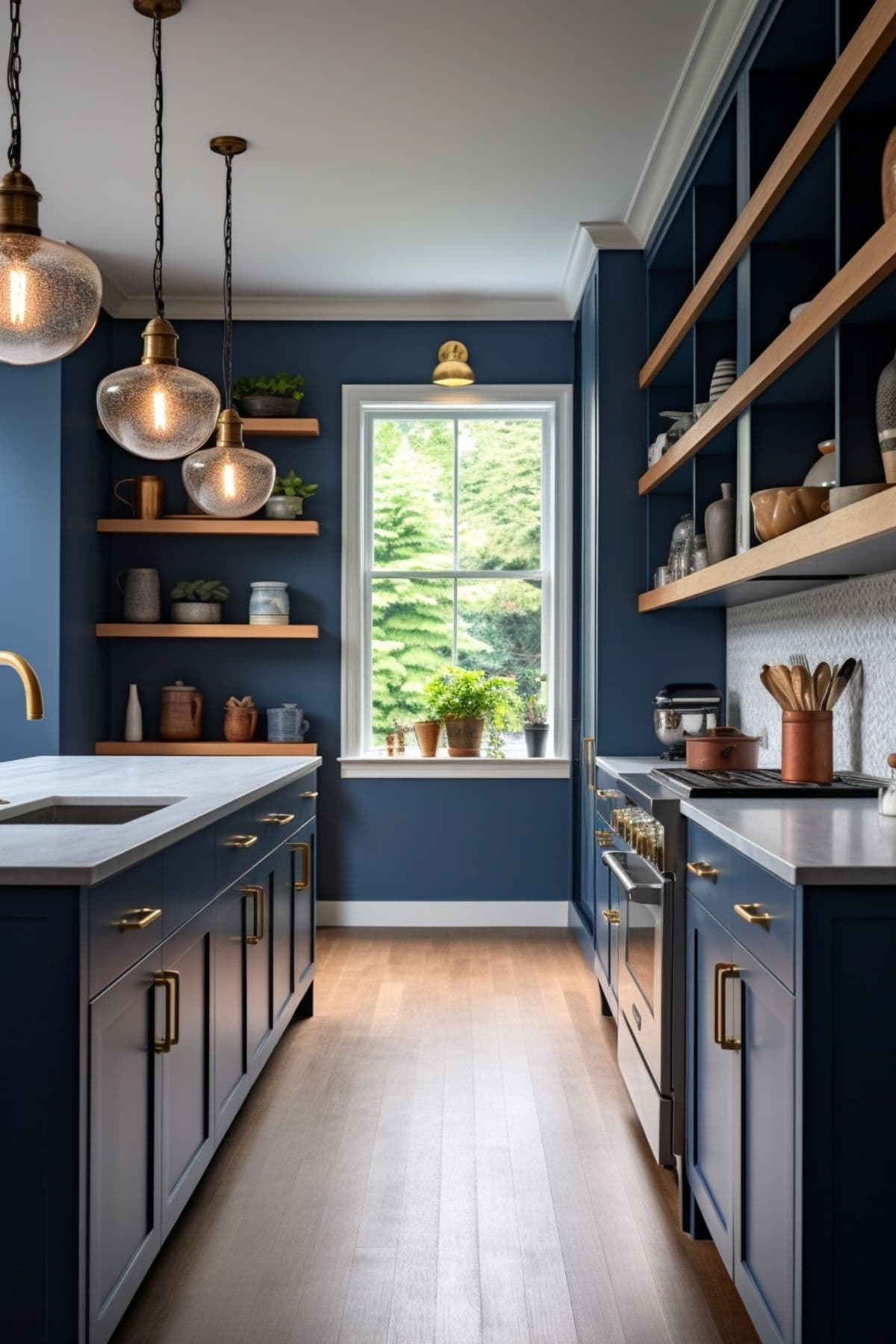Introduction:
Blue kitchen walls have emerged as a popular choice for homeowners seeking to infuse their culinary spaces with a sense of tranquility, sophistication, and style. From soft and serene hues to bold and vibrant shades, blue offers versatility and elegance that complements a wide range of kitchen designs. In this comprehensive guide, we’ll explore why blue has become one of the most popular colors for kitchen walls, discussing its various shades, psychological effects, and design considerations.

The Psychology of Blue:
Blue is often associated with qualities such as calmness, serenity, and stability, making it an ideal choice for kitchen walls. As a cool-toned color, blue has a calming effect on the mind and body, helping to create a peaceful and relaxing atmosphere in the kitchen. Additionally, blue is known to stimulate productivity and creativity, making it conducive to cooking, meal preparation, and socializing in the kitchen space.
Versatility of Blue Shades:
One of the reasons for the popularity of blue kitchen walls is the wide range of shades available, from soft pastels to rich jewel tones. Soft blues such as powder blue, sky blue, and aqua evoke a sense of tranquility and freshness, ideal for creating a light and airy ambiance in the kitchen. On the other hand, deeper shades of blue such as navy, cobalt, and indigo add drama and sophistication, making a bold statement in the kitchen space.
Complementary Color Palettes:
Blue kitchen walls pair beautifully with a variety of complementary color palettes, allowing homeowners to create a cohesive and harmonious look in their culinary spaces. For a classic and timeless appeal, pair blue walls with white cabinetry, countertops, and trim for a crisp and clean aesthetic. Alternatively, combine blue with warm neutrals such as beige, taupe, or gray for a cozy and inviting atmosphere.
Enhanced Lighting Effects:
Blue walls have the unique ability to enhance natural and artificial lighting effects in the kitchen, creating a bright and welcoming space. Lighter shades of blue reflect natural light, making the kitchen feel open and airy, while darker shades absorb light, creating a sense of intimacy and warmth. Additionally, blue walls can complement various lighting fixtures and accessories, such as pendant lights, sconces, and under-cabinet lighting, adding depth and dimension to the kitchen space.
Blue as a Statement Color:
In recent years, blue has emerged as a popular choice for homeowners looking to make a bold design statement in their kitchens. Vibrant shades of blue, such as teal, turquoise, and sapphire, add a pop of color and personality to the space, infusing it with energy and vibrancy. Whether used as an accent wall, cabinetry color, or overall wall color, blue makes a memorable impression and adds visual interest to the kitchen.
Creating a Coastal or Nautical Theme:
Blue kitchen walls are often associated with coastal or nautical themes, evoking images of sandy beaches, sparkling waters, and clear blue skies. Soft shades of blue paired with white or sandy beige accents create a serene and relaxing coastal-inspired look, perfect for beachfront or lakeside homes. Incorporate natural materials such as wood, rattan, and seagrass to enhance the coastal vibe and bring the outdoors inside.
Balancing Warm and Cool Tones:
When using blue on kitchen walls, it’s essential to balance warm and cool tones to create a harmonious and inviting space. Warm wood tones, such as oak, maple, or walnut, provide a natural contrast to cool blue walls, adding warmth and texture to the kitchen. Incorporate warm metallic finishes, such as brass or copper hardware and fixtures, to further balance the coolness of blue and create visual interest.
Considerations for Small Spaces:
In smaller kitchen spaces, lighter shades of blue are often preferred to maximize the feeling of openness and brightness. Soft pastel blues, such as baby blue or sky blue, create a sense of airiness and expansiveness, making the space feel larger and more inviting. Avoid using dark or intense shades of blue in small kitchens, as they can make the space feel cramped and claustrophobic.
Maintaining Balance with Accents and Accessories:
When incorporating blue kitchen walls into your design scheme, it’s essential to maintain balance with accents and accessories. Choose complementary accent colors, such as yellow, green, or coral, to add pops of color and visual interest throughout the space. Incorporate blue into your kitchen decor through textiles, artwork, dinnerware, and small appliances, creating a cohesive and harmonious look.
Conclusion:
Blue kitchen walls have earned their status as a popular choice for homeowners seeking to create a stylish, tranquil, and inviting culinary space. From its calming psychological effects to its versatility in shades and design possibilities, blue offers endless opportunities for personalization and expression in the kitchen. Whether used as a subtle backdrop or a bold statement color, blue brings a timeless elegance and sophistication to any kitchen design, making it a beloved choice for modern homes.